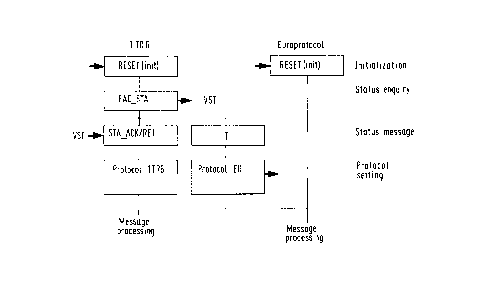Une partie des informations de ce site Web a été fournie par des sources externes. Le gouvernement du Canada n'assume aucune responsabilité concernant la précision, l'actualité ou la fiabilité des informations fournies par les sources externes. Les utilisateurs qui désirent employer cette information devraient consulter directement la source des informations. Le contenu fourni par les sources externes n'est pas assujetti aux exigences sur les langues officielles, la protection des renseignements personnels et l'accessibilité.
L'apparition de différences dans le texte et l'image des Revendications et de l'Abrégé dépend du moment auquel le document est publié. Les textes des Revendications et de l'Abrégé sont affichés :
| (12) Brevet: | (11) CA 2062621 |
|---|---|
| (54) Titre français: | ADAPTATION DE PROTOCOLE |
| (54) Titre anglais: | PROTOCOL ADAPTATION |
| Statut: | Périmé et au-delà du délai pour l’annulation |
| (51) Classification internationale des brevets (CIB): |
|
|---|---|
| (72) Inventeurs : |
|
| (73) Titulaires : |
|
| (71) Demandeurs : |
|
| (74) Agent: | SMART & BIGGAR LP |
| (74) Co-agent: | |
| (45) Délivré: | 1998-05-19 |
| (22) Date de dépôt: | 1992-03-10 |
| (41) Mise à la disponibilité du public: | 1992-09-12 |
| Requête d'examen: | 1994-11-22 |
| Licence disponible: | S.O. |
| Cédé au domaine public: | S.O. |
| (25) Langue des documents déposés: | Anglais |
| Traité de coopération en matière de brevets (PCT): | Non |
|---|
| (30) Données de priorité de la demande: | ||||||
|---|---|---|---|---|---|---|
|
Si un nouveau protocole est adopté dans tous les centraux (VST), p. ex. le protocole ETSI T/S 46-30 en Europe, il faudra remplacer l'ancien protocole (p. ex. 1TR6 en Allemagne) par le protocole ETSI dans tous les terminaux sans avoir à effectuer d'adaptation matérielle/logicielle sur place. cette fin, le terminal est adapté à l'avance à deux protocoles (1TR6, ETSI-T/S 46-30) (stockés dans des EEPROM, p. ex.), et lors de la conversion du central, le protocole en usage est demandé au central au moyen d'une interrogation d'état non ambiguë. Le terminal est ensuite exploité conformément à un message d'état indiquant le protocole utilisé par le central.
If a new protocol is introduced in all exchanges (VST),
e.g., the ETSI protocol T/S 46-30 in Europe, the old
protocol (e.g., 1TR6 in Germany) is to be replaced by the
ETSI protocol in all terminals without the need for
an on-site hardware/software adaptation.
To accomplish this, the terminal is provided in advance
with two protocols (1TR6, ETSI-T/S 46-30) (stored in
EEPROMs, for example), and by means of an unambiguous
status inquiry at the time of conversion in the exchange,
the latter is interrogated for the current protocol. The
terminal is then operated in accordance with a status
message indicating the protocol being used by the exchange.
Note : Les revendications sont présentées dans la langue officielle dans laquelle elles ont été soumises.
Note : Les descriptions sont présentées dans la langue officielle dans laquelle elles ont été soumises.

2024-08-01 : Dans le cadre de la transition vers les Brevets de nouvelle génération (BNG), la base de données sur les brevets canadiens (BDBC) contient désormais un Historique d'événement plus détaillé, qui reproduit le Journal des événements de notre nouvelle solution interne.
Veuillez noter que les événements débutant par « Inactive : » se réfèrent à des événements qui ne sont plus utilisés dans notre nouvelle solution interne.
Pour une meilleure compréhension de l'état de la demande ou brevet qui figure sur cette page, la rubrique Mise en garde , et les descriptions de Brevet , Historique d'événement , Taxes périodiques et Historique des paiements devraient être consultées.
| Description | Date |
|---|---|
| Inactive : CIB expirée | 2022-01-01 |
| Inactive : CIB de MCD | 2006-03-11 |
| Le délai pour l'annulation est expiré | 2003-03-10 |
| Lettre envoyée | 2002-03-11 |
| Accordé par délivrance | 1998-05-19 |
| Inactive : Taxe finale reçue | 1998-01-29 |
| Préoctroi | 1998-01-29 |
| Un avis d'acceptation est envoyé | 1997-11-14 |
| Un avis d'acceptation est envoyé | 1997-11-14 |
| Lettre envoyée | 1997-11-14 |
| Inactive : Renseign. sur l'état - Complets dès date d'ent. journ. | 1997-11-07 |
| Inactive : Dem. traitée sur TS dès date d'ent. journal | 1997-11-07 |
| Inactive : CIB enlevée | 1997-11-04 |
| Inactive : CIB en 1re position | 1997-11-04 |
| Inactive : CIB attribuée | 1997-11-04 |
| Inactive : CIB attribuée | 1997-11-04 |
| Inactive : Approuvée aux fins d'acceptation (AFA) | 1997-11-03 |
| Exigences pour une requête d'examen - jugée conforme | 1994-11-22 |
| Toutes les exigences pour l'examen - jugée conforme | 1994-11-22 |
| Demande publiée (accessible au public) | 1992-09-12 |
Il n'y a pas d'historique d'abandonnement
Le dernier paiement a été reçu le 1998-02-23
Avis : Si le paiement en totalité n'a pas été reçu au plus tard à la date indiquée, une taxe supplémentaire peut être imposée, soit une des taxes suivantes :
Veuillez vous référer à la page web des taxes sur les brevets de l'OPIC pour voir tous les montants actuels des taxes.
| Type de taxes | Anniversaire | Échéance | Date payée |
|---|---|---|---|
| Taxe finale - générale | 1998-01-29 | ||
| TM (demande, 6e anniv.) - générale | 06 | 1998-03-10 | 1998-02-23 |
| TM (brevet, 7e anniv.) - générale | 1999-03-10 | 1999-02-17 | |
| TM (brevet, 8e anniv.) - générale | 2000-03-10 | 2000-02-11 | |
| TM (brevet, 9e anniv.) - générale | 2001-03-12 | 2001-02-16 |
Les titulaires actuels et antérieures au dossier sont affichés en ordre alphabétique.
| Titulaires actuels au dossier |
|---|
| ALCATEL N.V. |
| Titulaires antérieures au dossier |
|---|
| RUDOLF HOYLER |
| WOLFGANG ARNOLD |